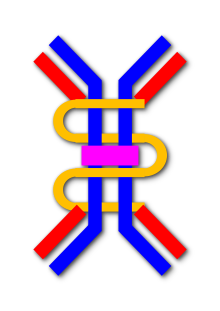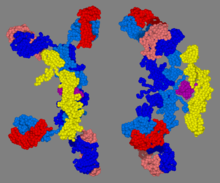Immunoglobulin A



Immunoglobulin A(Ig A,also referred to assIgAin its secretory form) is anantibodythat plays a role in theimmune functionofmucous membranes.The amount of IgA produced in association with mucosal membranes is greater than all other types of antibody combined.[3]In absolute terms, between three and five grams are secreted into the intestinallumeneach day.[4]This represents up to 15% of total immunoglobulins produced throughout the body.[5]
IgA has two subclasses (IgA1andIgA2) and can be produced as a monomeric as well as a dimeric form. The IgA dimeric form is the most prevalent and, when it has bound the Secretory component, is also calledsecretory IgA(sIgA). sIgA is the mainimmunoglobulinfound inmucous secretions,includingtears,saliva,sweat,colostrumand secretions from thegenitourinary tract,gastrointestinal tract,prostateandrespiratory epithelium.It is also found in small amounts in blood. The secretory component of sIgA protects the immunoglobulin from being degraded by proteolytic enzymes; thus, sIgA can survive in the harshgastrointestinal tractenvironment and provide protection againstmicrobesthat multiply in body secretions.[6]sIgA can also inhibit inflammatory effects of other immunoglobulins.[7]IgA is a poor activator of thecomplement system,andopsonizesonly weakly.[citation needed]
Forms[edit]
IgA1 vs. IgA2[edit]
IgA exists in twoisotypes,IgA1 and IgA2. They are both heavilyglycosylatedproteins.[8]While IgA1 predominates in serum (~80%), IgA2 percentages are higher in secretions than in serum (~35% in secretions);[9]the ratio of IgA1 and IgA2 secreting cells varies in the different lymphoid tissues of the human body:[10]
- IgA1 is the predominant IgA subclass found in serum. Most lymphoid tissues have a predominance of IgA1-producing cells.[11]
- In IgA2, the heavy and light chains are not linked withdisulfide,but withnon-covalentbonds. In secretory lymphoid tissues (e.g.,gut-associated lymphoid tissue,or GALT), the share of IgA2 production is larger than in the non-secretory lymphoid organs (e.g. spleen, peripheral lymph nodes).
Both IgA1 and IgA2 have been found in external secretions likecolostrum,maternal milk,tearsandsaliva,where IgA2 is more prominent than in the blood.[9] Polysaccharide antigens tend to induce more IgA2 than protein antigens.[10]
Both IgA1 and IgA2 can be in membrane-bound form.[12](seeB-cell receptor)
Serum vs. secretory IgA[edit]
It is also possible to distinguish forms of IgA based upon their location – serum IgA vs. secretory IgA.[citation needed]
In secretory IgA, the form found in secretions,polymersof 2–4 IgAmonomersare linked by two additional chains; as such, themolecular weightof slgA is 385kD. One of these is theJ chain(joining chain), which is apolypeptideof molecular mass 15kD, rich withcysteineand structurally completely different from other immunoglobulin chains. This chain is formed in the IgA-secreting cells.[citation needed]
The oligomeric forms of IgA in the external (mucosal) secretions also contain a polypeptide of a much larger molecular mass (70 kD) called thesecretory componentthat is produced byepithelial cells.This molecule originates from the poly-Ig receptor (130 kD) that is responsible for the uptake and transcellular transport of oligomeric (but not monomeric) IgA across the epithelial cells and into secretions such as tears, saliva, sweat and gut fluid.[citation needed]
Physiology[edit]
Serum IgA[edit]
In the blood, IgA interacts with anFc receptorcalled FcαRI (orCD89), which is expressed on immune effector cells, to initiate inflammatory reactions.[13]Ligation of FcαRI by IgA containing immune complexes causesantibody-dependent cell-mediated cytotoxicity(ADCC), degranulation ofeosinophilsandbasophils,phagocytosisbymonocytes,macrophages,andneutrophils,and triggering of respiratory burst activity bypolymorphonuclear leukocytes.[13]
Secretory IgA[edit]
The high prevalence of IgA in mucosal areas is a result of a cooperation betweenplasma cellsthat produce polymeric IgA (pIgA), and mucosal epithelial cells that expresspolymeric immunoglobulin receptor(pIgR).[13]Polymeric IgA (mainly the secretory dimer) is produced byplasma cellsin thelamina propriaadjacent to mucosal surfaces. It binds to the pIgR on thebasolateralsurface of epithelial cells, and is taken up into the cell viaendocytosis.The receptor-IgA complex passes through the cellular compartments before being secreted on theluminal surfaceof the epithelial cells, still attached to the receptor.Proteolysisof the receptor occurs, and the dimeric IgA molecule, along with a portion of the receptor known as thesecretory component(SC), is free to diffuse throughout thelumen,with dimeric IgA and SC together forming the so-called secretory IgA (sIgA)[14]In the gut, IgA can bind to the mucus layer covering the epithelial cells. In this way, a barrier capable of neutralizing threats before they reach the epithelial cells is formed.[citation needed]
Secretory IgA levels fluctuate diurnally, with the highest levels found in the small intestine and feces around ZT6, the middle of the light period.[15]The regulation of IgA secretion is related to the microbiota, and IgA is known to control specific members of oscillating microbes through direct interactions.[15]However, the underlying cause of the rhythmic secretion of IgA is not completely understood and may differ from one region of the body to another.
Production of sIgA against specific antigens depends on sampling ofM cellsand underlyingdendritic cells,T cell activation, and B cellclass switchingin GALT,mesenteric lymph nodes,and isolated lymphoid follicles in the small intestine.[16]
sIgA primarily acts by blockadingepithelialreceptors (e.g. by binding their ligands on pathogens), by sterically hindering attachment to epithelial cells, and by immune exclusion.[16]Immune exclusion is a process of agglutinatingpolyvalentantigens or pathogens by crosslinking them with antibody, trapping them in the mucus layer, and/or clearing themperistaltically.The oligosaccharide chains of the component of IgA can associate with the mucus layer that sits atop epithelial cells.[16]Since sIgA is a poor opsonin and activator of complement, simply binding a pathogen isn't necessarily enough to contain it—specific epitopes may have to be bound tosterically hinderaccess to the epithelium.[16]
Clearance of IgA is mediated at least in part byasialoglycoprotein receptors,which recognizesgalactose-terminating IgA N-glycans.[8]
Pathology[edit]
Genetic[edit]
Decreased or absent IgA due to an inherited inability to produce IgA is termedselective IgA deficiencyand can produce a clinically significantimmunodeficiency.[17]
Anti-IgA antibodies, sometimes present in individuals with low or absent IgA, can result in serious anaphylactic reactions when transfused with blood products that incidentally contain IgA. However, most persons with suspected IgA anaphylactic reactions had experienced acute generalized reactions that were from causes other than anti-IgA transfusion.[18]
Microbial[edit]
Neisseriaspecies includingNeisseria gonorrhoeae(which causesgonorrhea),[19]Streptococcus pneumoniae,[20]andHaemophilus influenzaetype B[21]all release aprotease that destroys IgA.Additionally,Blastocystisspecies have been shown to have several subtypes that generatecysteineandaspartic proteaseenzymes which degrade human IgA.[22]
Autoimmune and immune-mediated[edit]
IgA nephropathyis caused by IgA deposits in the kidneys. The pathogenesis involves the production of hypoglycosylated IgA1, which accumulates and subsequently leads to the formation of immune complexes and the production of IgA-specific IgG, further leading to tissue inflammation.[23]
Celiac diseaseinvolves IgA pathology due to the presence of IgA antiendomysial antibodies.[24][25]Additional testing has been conducted using IgA trans-glutaminase autoantibodies which has been identified as a specific and sensitive for the detection of celiac disease.[26][27]
Henoch–Schönlein purpura(HSP) is a systemic vasculitis caused by deposits of IgA andcomplement component 3(C3) in small blood vessels. HSP occurs usually in small children and involves the skin and connective tissues, scrotum, joints, gastrointestinal tract and kidneys. It usually follows an upper respiratory infection and resolves within a couple weeks as the liver clears out the IgA aggregates.[28]
Linear IgA bullous dermatosis and IgA pemphigus are two examples of IgA-mediated immunobullous diseases. IgA-mediated immunobullous diseases can often be difficult to treat even with usually effective medications such as rituximab.[29]
Drug-induced[edit]
Vancomycincan induce a linear IgA bullous dermatosis in some patients.[30]
See also[edit]
References[edit]
- ^Bonner A, Almogren A, Furtado PB, Kerr MA, Perkins SJ (January 2009)."Location of secretory component on the Fc edge of dimeric IgA1 reveals insight into the role of secretory IgA1 in mucosal immunity".Mucosal Immunology.2(1): 74–84.doi:10.1038/mi.2008.68.PMID19079336.
- ^Bonner A, Almogren A, Furtado PB, Kerr MA, Perkins SJ (February 2009)."The nonplanar secretory IgA2 and near planar secretory IgA1 solution structures rationalize their different mucosal immune responses".The Journal of Biological Chemistry.284(8): 5077–87.doi:10.1074/jbc.M807529200.PMC2643523.PMID19109255.
- ^Făgărășan S.;Honjo T. (January 2003). "Intestinal IgA synthesis: regulation of front-line body defences".Nature Reviews. Immunology.3(1): 63–72.doi:10.1038/nri982.PMID12511876.S2CID2586305.
- ^Brandtzaeg P, Pabst R (November 2004). "Let's go mucosal: communication on slippery ground".Trends in Immunology.25(11): 570–7.doi:10.1016/j.it.2004.09.005.PMID15489184.
- ^Macpherson AJ, Slack E (November 2007). "The functional interactions of commensal bacteria with intestinal secretory IgA".Current Opinion in Gastroenterology.23(6): 673–8.doi:10.1097/MOG.0b013e3282f0d012.PMID17906446.S2CID8445606.
- ^Junqueira LC, Carneiro J (2003).Basic Histology.McGraw-Hill.ISBN978-0-8385-0590-8.[page needed]
- ^Holmgren J, Czerkinsky C (April 2005)."Mucosal immunity and vaccines".Nature Medicine.11(4 Suppl): S45–53.doi:10.1038/nm1213.PMID15812489.
- ^abMaverakis E, Kim K, Shimoda M, Gershwin ME, Patel F, Wilken R, Raychaudhuri S, Ruhaak LR, Lebrilla CB (February 2015)."Glycans in the immune system and The Altered Glycan Theory of Autoimmunity: a critical review".Journal of Autoimmunity.57:1–13.doi:10.1016/j.jaut.2014.12.002.PMC4340844.PMID25578468.
- ^abDelacroix DL, Dive C, Rambaud JC, Vaerman JP (October 1982)."IgA subclasses in various secretions and in serum".Immunology.47(2): 383–5.PMC1555453.PMID7118169.
- ^abSimell B, Kilpi T, Käyhty H (March 2006)."Subclass distribution of natural salivary IgA antibodies against pneumococcal capsular polysaccharide of type 14 and pneumococcal surface adhesin A (PsaA) in children".Clinical and Experimental Immunology.143(3): 543–9.doi:10.1111/j.1365-2249.2006.03009.x.PMC1809616.PMID16487254.
- ^Macpherson AJ, McCoy KD, Johansen FE, Brandtzaeg P (January 2008)."The immune geography of IgA induction and function".Mucosal Immunology.1(1): 11–22.doi:10.1038/mi.2007.6.PMID19079156.
- ^Hung AF, Chen JB, Chang TW (August 2008). "Alleles and isoforms of human membrane-bound IgA1".Molecular Immunology.45(13): 3624–30.doi:10.1016/j.molimm.2008.04.023.PMID18538846.S2CID26094982.
- ^abcSnoeck V, Peters IR, Cox E (2006)."The IgA system: a comparison of structure and function in different species"(PDF).Veterinary Research.37(3): 455–67.doi:10.1051/vetres:2006010.PMID16611558.
- ^Kaetzel CS, Robinson JK, Chintalacharuvu KR, Vaerman JP, Lamm ME (October 1991)."The polymeric immunoglobulin receptor (secretory component) mediates transport of immune complexes across epithelial cells: a local defense function for IgA".Proceedings of the National Academy of Sciences of the United States of America.88(19): 8796–800.Bibcode:1991PNAS...88.8796K.doi:10.1073/pnas.88.19.8796.PMC52597.PMID1924341.
- ^abRatiner, Karina; Fachler-Sharp, Tahel; Elinav, Eran (16 January 2023)."Small Intestinal Microbiota Oscillations, Host Effects and Regulation-A Zoom into Three Key Effector Molecules".Biology.12(1): 142.doi:10.3390/biology12010142.PMC9855434.PMID36671834.
- ^abcdMantis NJ, Rol N, Corthésy B (November 2011)."Secretory IgA's complex roles in immunity and mucosal homeostasis in the gut".Mucosal Immunology.4(6): 603–11.doi:10.1038/mi.2011.41.PMC3774538.PMID21975936.
- ^Yel L (January 2010)."Selective IgA deficiency".Journal of Clinical Immunology.30(1): 10–6.doi:10.1007/s10875-009-9357-x.PMC2821513.PMID20101521.
- ^Sandler SG, Mallory D, Malamut D, Eckrich R (January 1995). "IgA anaphylactic transfusion reactions".Transfusion Medicine Reviews.9(1): 1–8.doi:10.1016/S0887-7963(05)80026-4.PMID7719037.
- ^Halter R, Pohlner J, Meyer TF (July 1984)."IgA protease of Neisseria gonorrhoeae: isolation and characterization of the gene and its extracellular product".The EMBO Journal.3(7): 1595–601.doi:10.1002/j.1460-2075.1984.tb02016.x.PMC557564.PMID6430698.
- ^Proctor M, Manning PJ (September 1990)."Production of immunoglobulin A protease by Streptococcus pneumoniae from animals".Infection and Immunity.58(9): 2733–7.doi:10.1128/IAI.58.9.2733-2737.1990.PMC313560.PMID2117567.
- ^St Geme JW, de la Morena ML, Falkow S (October 1994). "A Haemophilus influenzae IgA protease-like protein promotes intimate interaction with human epithelial cells".Molecular Microbiology.14(2): 217–33.doi:10.1111/j.1365-2958.1994.tb01283.x.PMID7830568.S2CID30615746.
- ^Roberts T, Stark D, Harkness J, Ellis J (2014)."Update on the pathogenic potential and treatment options for Blastocystis sp".Gut Pathogens.6:17.doi:10.1186/1757-4749-6-17.PMC4039988.PMID24883113.
- ^Lai, Kar Neng; Tang, Sydney C. W.; Schena, Francesco Paolo; Novak, Jan; Tomino, Yasuhiko; Fogo, Agnes B.; Glassock, Richard J. (2016)."IgA nephropathy".Nature Reviews Disease Primers.2:16001.doi:10.1038/nrdp.2016.1.PMID27189177.S2CID3989355.
- ^Prince HE, Norman GL, Binder WL (March 2000)."Immunoglobulin A (IgA) deficiency and alternative celiac disease-associated antibodies in sera submitted to a reference laboratory for endomysial IgA testing".Clinical and Diagnostic Laboratory Immunology.7(2): 192–6.doi:10.1128/cdli.7.2.192-196.2000.PMC95847.PMID10702491.
- ^Cunningham-Rundles C (September 2001). "Physiology of IgA and IgA deficiency".Journal of Clinical Immunology.21(5): 303–9.doi:10.1023/A:1012241117984.PMID11720003.S2CID13285781.
- ^Malamut G, Cording S, Cerf-Bensussan N (June 26, 2019)."Recent advances in celiac disease and refractory celiac disease".F1000Res.8:969.doi:10.12688/f1000research.18701.1.PMC6600866.PMID31297187.
- ^Cunningham-Rundles C (February 2000). "Comparison of assays for anti-endomysial and anti-transglutaminase antibodies for diagnosis of pediatric celiac disease".The Israel Medical Association Journal.2(2): 122–5.PMID10804933.
- ^Rai A, Nast C, Adler S (December 1999)."Henoch-Schönlein purpura nephritis".Journal of the American Society of Nephrology.10(12): 2637–44.doi:10.1681/ASN.V10122637.PMID10589705.
- ^He Y, Shimoda M, Ono Y, Villalobos IB, Mitra A, Konia T, Grando SA, Zone JJ, Maverakis E (June 2015)."Persistence of Autoreactive IgA-Secreting B Cells Despite Multiple Immunosuppressive Medications Including Rituximab".JAMA Dermatology.151(6): 646–50.doi:10.1001/jamadermatol.2015.59.PMID25901938.
- ^Go JR, Abu Saleh OM (October 2020). "Vancomycin-Induced Linear IgA Bullous Dermatosis".The New England Journal of Medicine.383(16): 1577.doi:10.1056/NEJMicm2003334.PMID33053287.S2CID222420540.
External links[edit]
- Immunoglobulin+Aat the U.S. National Library of MedicineMedical Subject Headings(MeSH)
- Herich, R. (2017)."Is the role of IgA in local immunity completely known?".Food and Agricultural Immunology.28(2): 223–237.doi:10.1080/09540105.2016.1258547.
